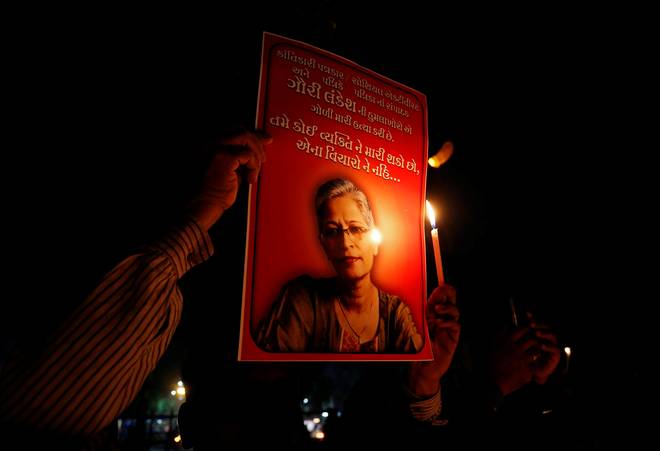A New Republic Where Voices of Dissent Must Be Targeted, Hounded and Killed
MOHAN J.DUTTA

SINGAPORE: It is a surreal experience. Reading the story of the violent murder of the courageous journalist Gauri Lankesh and processing the gush of rage I am experiencing. And reading a glossy poster from a Think Tank here in Singapore advertising India’s successful smart nation story.
On one hand, in Modi’s Republic, voices of dissent must be targeted, hounded, and killed.
The killing of Lankesh is an expression of a climate of violence that reiterates and reproduces itself from Twitter handles and Facebook posts to the screens of Republic TV to lynchings and murders targeting minorities and dissenters.
Through her Kannada newspaper, Gauri Lankesh Patrike, that did not take advertising revenues from corporates or state agencies to maintain its independent stance, Lankesh had been critical of the BJP’s Hindu nationalist agenda. In a strong voice, she condemned the concerted efforts of the BJP and its allied extreme-right parties/groups at turning India into a Hindu nation. A voice of conscience, she drew attention to the increasing climate of communalism being catalyzed by the BJP.
Lankesh criticized the violence built into the caste structure of Hinduism, and opposed the Hindutva strategies of deploying threats, intimidation and violence against those opposed to Hindu nationalism.
Also, she had been running a series of stories on alleged corruptions in the dealings of a Bharatiya Janata Party (BJP) lawmaker from Karnataka. She had been sued for defamation for running the stories, was out on bail, and had been appealing the lawsuit.
In doing all this, she drew the ire of Hindutva forces. That Gauri Lankesh had received threats of violence and abuse on social media and on the phone depicts the strategic use of violence as a tool for crafting the imaginary of India as a Hindu nation. That the right wing Hindutva social media is resurgent with expressions of glee and sinister threats to dissenters is further testimony to the role of violence in asserting Hindutva hegemony. That the Prime Minister Mr. Modi follows some of the Twitter handles making violent proclamations of the murder and threatening journalists is the ultimate testimony to the institutional role in seeding violence as a state strategy. The very pluralist basis of Indian democracy is a threat that must be obliterated through the systematic deployment of violence.
There is no room for dissent in this imagination of the Hindu nation. One built on the monoculture of Hindu hatred, for minorities, for rationalists, for Communists, for liberals, and for any other voices that interrogates the hegemony of the Hindutva story. There is no room for dialogue or debate in a public sphere that is rife with mainstream journalists cozying up to the BJP agenda of labeling and targeting anti-nationals.
On the other hand, to an international audience, India is a global leader in its digital innovations, as an example of a smart nation with a plethora of digital initiatives. The smart transformations in digital economies are being led by India, the well-crafted publicity material of the Think Tank tells me.
I am reminded, India’s Prime Minister Narendra Modi is a leader in showing strong governance in transforming the economy into a digital economy. The demonetization story is spun as the story of effective management of digital transformations, irrespective of the evidence that documents the effects of the demonetization efforts on the poor and the middle classes, and the failure of demonetization in bringing about any real changes to the landscape of corruption.
Modi’s India carefully crafted in the image-making of the branding tools of “Digital India” is the obverse of the India being targeted by the Hindutva brigade for a make-over as a Hindu Rashtra.
Two different worlds. A strategically constructed image through public relations and advertising dollars and international public diplomacy, and an everyday reality of chilling dissent.
The projection of an image of India to a global audience that celebrates its digital story and its success in digital innovations is a make-believe branding campaign targeted at cultivating an image of a modern India, packaged with cultural artefacts and relics that celebrate its diverse history. As branding campaigns come, this is an exercise in concocting fictions, and attaching these fictive imaginations to seductive invitations for foreign direct investments, trade, and private-public partnerships.
This image is thoroughly discredited in the face of courageous news stories from journalists like Gauri Lankesh that document the realities in India. The narrative accounts of the real struggles of the poor in the wake of demonetization are inconvenient truths that threaten the exercise of image-making. The targeting of India’s Muslim minorities through lynchings and strategically crafted riots disrupts the “Digital India” story being peddled in investment destinations like Singapore and the U.S. The poor governance and development indicators of India stand as eye sores to brand “Make in India.”
The stories that Gauri Lankesh wrote punctured the BJP’s hate mongering tactics, looking the Hindutva ideology in its face and calling it out for its blatant ugliness. Lankesh was targeted precisely because her written words disrupted the carefully managed Hindutva ideology. The verbal threats made to her and many other journalists did not deter her.
Responding to the attacks, protests have emerged from across India. Courageous voices of journalists and activists across India have stood up to protest the murder, sending a strong message to the regime: Your strategies of silencing dissent are not working.
Activists gathered at the Press Club and in cities across India holding signs that read, “#IamGauri” and chanting slogans, “May Gauri Lankesh remain immortal” offer another imaginary of the Indian nation that defy the BJP’s violent nation, smart nation strategies: They remind us that India is still a democracy, with plural voices, and with a long tradition of journalists like Gauri Lankesh who stare the Hindutva forces in their face, and declare: “We are not afraid.”
(Mohan J. Dutta is Provost's Chair Professor of Communications and New Media, National University of Singapore)



